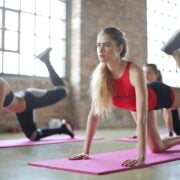
Rise and Shine: Energize Your Day with These Good Morning Exercises
Starting your day with exercise can have numerous benefits for both your physical and mental well-being. Not only does it help to wake up your body and increase your energy levels, but it can also set a positive tone for the rest of your day. In this article, we will explore the importance of starting your day with exercise and provide examples of different types of exercises you can incorporate into your morning routine.
Key Takeaways
- Starting your day with exercise can improve your overall health and well-being.
- Stretching exercises can help wake up your body and prepare you for the day ahead.
- Cardiovascular exercises can boost your energy levels and improve your mood.
- Yoga poses can calm your mind and body, reducing stress and anxiety.
- Strength training exercises can build endurance and improve your overall fitness level.
The Importance of Starting Your Day with Exercise
Exercising in the morning has been shown to have several benefits. First and foremost, it helps to jumpstart your metabolism, allowing you to burn more calories throughout the day. This can be especially beneficial if you are trying to lose weight or maintain a healthy weight. Additionally, morning exercise has been found to improve cognitive function and enhance mental clarity, making it easier for you to focus and be productive throughout the day.
Furthermore, starting your day with exercise can help to reduce stress and improve your mood. Exercise releases endorphins, which are known as “feel-good” hormones that can boost your mood and reduce feelings of anxiety or depression. By exercising in the morning, you can set a positive tone for the rest of your day and approach any challenges or tasks with a more positive mindset.
Stretching Exercises to Wake Up Your Body
Stretching is an excellent way to wake up your body and prepare it for the day ahead. It helps to increase blood flow to your muscles, improve flexibility, and reduce the risk of injury. Some examples of stretching exercises you can do in the morning include:
1. Neck stretches: Gently tilt your head from side to side, forward and backward, and rotate it in a circular motion to release tension in your neck muscles.
2. Shoulder rolls: Roll your shoulders forward and backward in a circular motion to loosen up any tightness or stiffness.
3. Hamstring stretches: Sit on the edge of a chair and extend one leg straight out in front of you. Lean forward from your hips until you feel a stretch in the back of your thigh. Hold for 30 seconds and then switch legs.
4. Cat-Cow stretch: Get on all fours with your hands directly under your shoulders and your knees under your hips. Inhale as you arch your back and lift your head, and exhale as you round your spine and tuck your chin to your chest.
By incorporating these stretching exercises into your morning routine, you can help to wake up your body and prepare it for the day ahead.
Cardiovascular Exercises to Boost Your Energy Levels
| Exercise | Duration | Calories Burned | Heart Rate |
|---|---|---|---|
| Running | 30 minutes | 300 | 150 bpm |
| Cycling | 45 minutes | 400 | 130 bpm |
| Swimming | 60 minutes | 500 | 120 bpm |
| Jumping Jacks | 10 minutes | 100 | 140 bpm |
Cardiovascular exercises are a great way to boost your energy levels in the morning. They get your heart rate up, increase blood flow, and release endorphins, which can leave you feeling energized and ready to tackle the day. Some examples of cardiovascular exercises you can do in the morning include:
1. Running or jogging: Lace up your sneakers and go for a run or jog around your neighborhood or at a nearby park. Start with a brisk walk to warm up, and then gradually increase your pace to a jog or run.
2. Jumping jacks: Stand with your feet together and arms by your sides. Jump up, spreading your feet wider than hip-width apart, and raise your arms overhead. Jump back to the starting position and repeat.
3. Cycling: If you have access to a stationary bike or a regular bike, hop on and pedal away. You can adjust the resistance level to make it more challenging or vary the speed to keep things interesting.
4. High-intensity interval training (HIIT): HIIT workouts involve alternating between short bursts of intense exercise and periods of rest or lower-intensity exercise. This can be done with exercises like burpees, mountain climbers, or squat jumps.
By incorporating cardiovascular exercises into your morning routine, you can boost your energy levels and set a positive tone for the rest of your day.
Yoga Poses to Calm Your Mind and Body
Yoga is a great way to calm your mind and body in the morning. It combines physical movement with deep breathing and mindfulness, helping to reduce stress and promote relaxation. Some examples of yoga poses you can do in the morning include:
1. Child’s pose: Kneel on the floor with your knees hip-width apart and your toes touching. Sit back on your heels and fold forward, resting your forehead on the mat or a block. Extend your arms out in front of you or rest them alongside your body.
2. Downward-facing dog: Start on all fours with your hands directly under your shoulders and your knees under your hips. Lift your hips up and back, straightening your legs and pressing your heels toward the floor. Keep your head between your arms and relax your neck.
3. Tree pose: Stand tall with your feet hip-width apart. Shift your weight onto one foot and lift the other foot off the ground, placing the sole of your foot against the inner thigh or calf of your standing leg. Bring your hands together at your heart center or extend them overhead.
4. Corpse pose: Lie flat on your back with your arms by your sides and palms facing up. Close your eyes and focus on deep, slow breaths. Allow yourself to fully relax and let go of any tension in your body.
By incorporating these yoga poses into your morning routine, you can start your day with a sense of calmness and clarity.
Strength Training Exercises to Build Endurance
Strength training exercises are an excellent way to build endurance and increase muscle strength. They can also help to improve posture, increase bone density, and boost metabolism. Some examples of strength training exercises you can do in the morning include:
1. Squats: Stand with your feet shoulder-width apart and toes slightly turned out. Bend your knees and lower your hips down as if you were sitting back into a chair. Keep your chest lifted and your weight in your heels. Push through your heels to stand back up.
2. Push-ups: Start in a high plank position with your hands slightly wider than shoulder-width apart and your feet together. Lower your chest toward the floor by bending your elbows, keeping them close to your body. Push back up to the starting position.
3. Lunges: Stand with your feet hip-width apart and take a step forward with one foot. Bend both knees to lower your body down until your front thigh is parallel to the floor and your back knee is hovering just above the ground. Push through your front heel to stand back up and repeat on the other side.
4. Plank: Start in a high plank position with your hands directly under your shoulders and your feet hip-width apart. Engage your core and hold this position for as long as you can, making sure to keep your body in a straight line from head to toe.
By incorporating these strength training exercises into your morning routine, you can build endurance, increase muscle strength, and improve overall physical fitness.
Breathing Exercises to Increase Oxygen Flow
Breathing exercises are a simple yet effective way to increase oxygen flow to your body and promote relaxation. They can help to reduce stress, improve focus, and enhance overall well-being. Some examples of breathing exercises you can do in the morning include:
1. Deep belly breathing: Sit or lie down in a comfortable position. Place one hand on your belly and the other hand on your chest. Take a deep breath in through your nose, allowing your belly to rise as you fill your lungs with air. Exhale slowly through your mouth, allowing your belly to fall.
2. Alternate nostril breathing: Sit in a comfortable position and use your right thumb to close your right nostril. Inhale deeply through your left nostril, then use your right ring finger to close your left nostril. Exhale through your right nostril, then inhale through your right nostril. Close your right nostril with your thumb and exhale through your left nostril. Continue alternating for several breaths.
3. Box breathing: Sit or stand in a comfortable position and take a deep breath in through your nose for a count of four. Hold your breath for a count of four, then exhale slowly through your mouth for a count of four. Hold your breath again for a count of four before starting the cycle again.
By incorporating these breathing exercises into your morning routine, you can increase oxygen flow to your body, reduce stress, and promote a sense of calmness and relaxation.
Morning Exercises for Better Posture
Poor posture can lead to various health issues, including back pain, neck pain, and headaches. By incorporating specific exercises into your morning routine, you can improve your posture and reduce the risk of these problems. Some examples of exercises that can improve posture include:
1. Shoulder blade squeezes: Stand tall with your feet hip-width apart and arms by your sides. Squeeze your shoulder blades together as if you were trying to hold a pencil between them. Hold for a few seconds, then release.
2. Wall angels: Stand with your back against a wall and your feet hip-width apart. Bend your elbows to 90 degrees and press them against the wall. Slowly slide your arms up the wall as far as you can without lifting your elbows or arching your back. Slide them back down to the starting position.
3. Cat-Camel stretch: Get on all fours with your hands directly under your shoulders and your knees under your hips. Inhale as you arch your back and lift your head, and exhale as you round your spine and tuck your chin to your chest.
4. Plank with shoulder taps: Start in a high plank position with your hands directly under your shoulders and your feet hip-width apart. Engage your core and lift one hand off the ground to tap the opposite shoulder. Place it back down and repeat on the other side.
By incorporating these exercises into your morning routine, you can improve your posture and reduce the risk of pain or discomfort associated with poor posture.
Exercises to Improve Digestion and Metabolism
Regular exercise can help to improve digestion and boost metabolism. It can stimulate the muscles in your digestive tract, helping to move food through your system more efficiently. Additionally, exercise can increase muscle mass, which can help to increase metabolism and burn more calories. Some examples of exercises that can improve digestion and metabolism include:
1. Walking: Going for a brisk walk after a meal can help to stimulate digestion and prevent bloating or discomfort. Aim for at least 10-15 minutes of walking after each meal.
2. Twists: Sit on the floor with your legs extended in front of you. Bend one knee and place the foot on the outside of the opposite thigh. Twist your torso toward the bent knee, placing one hand on the floor behind you for support and the other hand on the outside of the bent knee. Hold for a few breaths, then switch sides.
3. Bicycle crunches: Lie flat on your back with your hands behind your head and your knees bent. Lift your head, shoulders, and feet off the ground, and bring one knee toward your chest while extending the other leg straight out. Twist your torso to bring the opposite elbow toward the bent knee. Switch sides in a pedaling motion.
4. Jumping rope: Jumping rope is a great cardiovascular exercise that can also help to improve digestion and boost metabolism. Start with a few minutes of jumping rope and gradually increase the duration as you build endurance.
By incorporating these exercises into your morning routine, you can improve digestion, boost metabolism, and support overall digestive health.
Fun and Creative Ways to Exercise in the Morning
Exercise doesn’t have to be boring or monotonous. There are plenty of fun and creative ways to get moving in the morning and make your exercise routine more enjoyable. Some examples include:
1. Dance party: Put on your favorite upbeat music and have a dance party in your living room. Let loose, move your body, and have fun.
2. Hula hooping: Grab a hula hoop and give it a whirl. Hula hooping is a great way to engage your core muscles and get your heart rate up.
3. Jumping on a trampoline: If you have access to a trampoline, spend a few minutes jumping on it in the morning. Not only is it fun, but it also provides a great cardiovascular workout.
4. Outdoor activities: Take advantage of the great outdoors and go for a hike, bike ride, or swim in the morning. Being in nature can boost your mood and make exercise more enjoyable.
By incorporating fun and creative exercises into your morning routine, you can make exercise more enjoyable and look forward to starting your day with movement.
Tips for Staying Motivated to Exercise Every Morning
Staying motivated to exercise every morning can be challenging, especially when you’re tired or not in the mood. However, there are several tips that can help you stay on track with your morning exercise routine:
1. Set realistic goals: Start small and set realistic goals for yourself. Instead of aiming for an hour-long workout every morning, start with 10-15 minutes and gradually increase the duration as you build endurance.
2. Find an accountability partner: Find a friend or family member who shares your goal of exercising in the morning and hold each other accountable. You can schedule regular workouts together or simply check in with each other to ensure you’re sticking to your routine.
3. Mix it up: Keep your exercise routine interesting by trying different types of exercises or varying the intensity. This can help to prevent boredom and keep you motivated to continue exercising every morning.
4. Reward yourself: Set up a reward system for yourself to celebrate your accomplishments. For example, treat yourself to a massage or a new workout outfit when you reach a certain milestone.
5. Track your progress: Keep a journal or use a fitness app to track your progress and see how far you’ve come. Seeing your improvements can be incredibly motivating and encourage you to continue with your morning exercise routine.
By implementing these tips, you can stay motivated and committed to exercising every morning, reaping the numerous benefits it has to offer.
Starting your day with exercise can have numerous benefits for both your physical and mental well-being. It can boost your energy levels, improve cognitive function, reduce stress, and promote a positive mindset. By incorporating stretching exercises, cardiovascular exercises, yoga poses, strength training exercises, breathing exercises, exercises for better posture, exercises to improve digestion and metabolism, and fun and creative exercises into your morning routine, you can set a positive tone for the rest of your day and enjoy the many benefits of starting your day with exercise. So why not give it a try? Wake up a little earlier, get moving, and see how it transforms your day for the better. Not only will you feel more energized and focused, but you may also notice improvements in your overall physical health and mental well-being. Remember, consistency is key, so make it a habit to start your day with exercise and reap the rewards. Don’t be afraid to mix it up and try different types of exercises to keep things interesting and prevent boredom. Your body and mind will thank you for it. So, set your alarm a little earlier, lace up your sneakers, and start your day off on the right foot with a morning workout. You won’t regret it!
If you’re looking for a way to kickstart your day with a burst of energy, you might want to consider incorporating the Good Morning exercise into your routine. This simple yet effective movement targets multiple muscle groups and can help improve your overall strength and flexibility. But did you know that there’s an article on Wave Magnets that dives deeper into the benefits and variations of the Good Morning exercise? Check it out here to learn more about how this exercise can enhance your fitness journey.
FAQs
What is good morning exercise?
Good morning exercise is a weight training exercise that targets the lower back, glutes, and hamstrings.
How is good morning exercise performed?
Good morning exercise is performed by standing with feet shoulder-width apart, placing a barbell across the back of the shoulders, and bending forward at the hips while keeping the back straight.
What are the benefits of good morning exercise?
Good morning exercise can help improve posture, strengthen the lower back, glutes, and hamstrings, and increase overall core stability.
Is good morning exercise suitable for beginners?
Good morning exercise is not recommended for beginners as it requires proper form and technique to avoid injury. It is best to consult with a fitness professional before attempting this exercise.
What are some variations of good morning exercise?
Some variations of good morning exercise include using dumbbells instead of a barbell, performing the exercise on a stability ball, or adding a twist at the end of the movement to engage the obliques.
How often should good morning exercise be performed?
Good morning exercise should be performed 1-2 times per week, with proper rest and recovery time in between workouts. It is important to listen to your body and not overdo it.

















